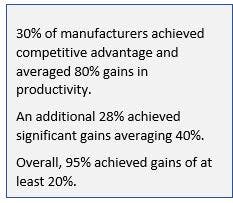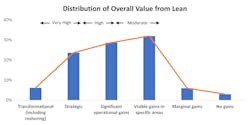Widespread Lean Adoption Would Make the US More Competitive
Raising individual company productivity is essential to revitalizing U.S. manufacturing. The U.S. market share for manufactured goods by domestic producers has been in decline for the last 20 years, reaching a record low of 66% in 2022, based on the CPA Domestic Market Share Index. Trade policy, legislation and federal funding are necessary to level the playing field against imports. However, a company that is not continuously raising its own productivity bar will lose competitive ground.
An ITIF analysis reports that productivity in the U.S. manufacturing sector has been flat to declining since 2011. To say that U.S. manufacturing is on a revitalized trajectory requires a quantum change in the number of globally competitive U.S. companies operating at top-tier productivity. A bold, audacious milestone would be 50,000 companies reaching this elevation by the year 2030.
U.S. manufacturers are facing many troubling headwinds: supply chain disruption; competing against lower labor cost countries; workforce shortages; energy transition; and broadly sharing in the benefits from advanced production technology and Industry 4.0, according to a recent McKinsey Global Report. All will be easier to confront with higher productivity.
Lean Boosts Productivity
Lean manufacturing is one of the few levers able to raise productivity at a national scale and drive a sustained reversal in the tidal outflow of manufacturing. Lean continuously eliminates waste and bottlenecks and improves customer value through employee engagement and data-driven tools.
Companies often look to technology and equipment investment as the solution to productivity. Produce more with less labor. Lean achieves productivity gains by focusing on workforce-based continuous improvement.
“Every company needs an army of creative problems solvers,” says Karl Wadensten, CEO, VIBCO Vibrators in Rhode Island.
Lean reduces the need for working capital, optimizes return on investment and drives innovation. Companies create a culture of experimentation and learning. This encourages employees to think creatively and can lead to the development of new technologies, products and business models, driving growth and creating new markets for U.S. manufacturers.
Research into Crossing the Chasm
A two-to-three times expansion of lean manufacturing adoption is the foundation for re-establishing the U.S. as a global leader. Think of that expansion in the context of the “crossing the chasm” framework for innovation adoption. Lean has not been widely deployed by the early and late mainstream majority.
Industry Reimagined 2030 conducted original research to shed light on what it will take to double or triple the adoption of Lean. We surveyed small, medium and large manufacturers and prepared “The State of Lean Manufacturing” report.
We Learned about the Gains that Companies Achieve
Companies deploying lean see the magnitude of potential gains. People on the sidelines often express disbelief.
Lean principles, tools and practices are timeless. The challenge is to adapt those principles to today and tomorrow’s business climate. Lean needs to achieve visible, impactful gains within the first six months; gains that directly tie to company priorities and demonstrate ROI. This is achieved when lean is adapted for rapid, iterative implementation and skill development shifts from classroom training to learn-by-doing.
Relevance is also tied to a clear understanding of the why and what of lean (25% of surveyed companies indicated that understanding was lacking). We are leaving untapped productivity on the table when people cannot relate to the benefits in individual terms (What’s in it for me, or WIIFM).
Lean is friendly when it is introduced in easy-to-understand terminology and when learn-by-doing happens in small pieces with team-based activities on the production floor. It is about more than individuals learning technical skills. Socializing lean among departments and peer groups is essential and at the heart of sustained culture change.
We Learned about How High Achievers Begin their Lean Journey
1. Start with the basics: a simple, broad orientation to the why, what, WIIFM to familiarize people with reducing waste, bottlenecks and improving flow.
2. Critical targets: Identify a few key improvement targets that are highly relevant to executives.
3. Selective engagement: Only train people who will work on the critical targets and only train them in the specific lean tools and practices they will use. People learn by doing.
4. Measure progress: Track improvements to build momentum and motivate employees by showing the impact of their efforts. Encourage experimentation and learning. Adjust tactics accordingly. Plan-Do-Check-Act.
5. Recognize effort: Show interest and say “thanks.” People will develop a sense of pride in their problem-solving work, their collaboration and their contribution to customer and company value.
6. Iterate: Continue to use lean to raise the bar and tackle the next competitive improvement.
We learned that high achievers cascade company priorities through to the production floor (enterprise alignment). Tracking and recognition provide the necessary feedback loop for sustaining a culture of continuous improvement. By adopting this approach, manufacturers will quickly see the benefits of lean manufacturing for long-term success.
One of the few levers for raising productivity at a national scale, lean manufacturing continuously eliminates waste and bottlenecks and improves customer value through employee engagement and utilizing data-driven tools. Yet only a small percentage of U.S. companies systematically use lean and reap its competitive and financial benefits. I stand for lean manufacturing becoming a national model.
The complete “State of Lean Manufacturing” report is freely available (download) and there is the opportunity to contribute to further research.
Based in the New York City area, Doug Berger is founder and president of the non-profit Industry Reimagined 2030, which is on a mission to revitalize U.S. manufacturing at a national scale. This article and the background research are based on the Reimagine Lean collaborative, comprised of Lean Manufacturing experts and thought-leaders aiming to move-the-dial on U.S. competitiveness and productivity.
****To comment on this article, please scroll down past story recommendations to "Voice Your Opinion."




